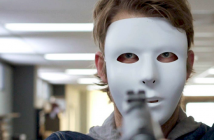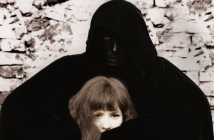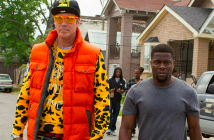
Editor’s Notes: The following review is part of our coverage for TIFF’s Dreaming in Technicolor. For more information on this TIFF film series visit http://tiff.net and follow TIFF on Twitter at @TIFF_NET.
“This here’s Bonnie Parker, and I’m Clyde Barrow. We rob banks.” When Warren Beatty spoke those words, I wonder if he realized they would go down in movie history as one of the best remembered quotes. They sum up exactly what Bonnie and Clyde were: bank robbers. It of course omits the fact that they were also mass murders, but that’s not often something one likes to say out loud (and it hadn’t happened yet in the film) and in 1931, robbing banks wasn’t really looked upon as something all that terrible to the populous, since the banks had all but robbed them due to the stock market crash of 1929 and over-lending (which unfortunately makes the film even more relevant today).
The power of Bonnie and Clyde has endured these 48 years and will continue to. The film is as surprising on a revisit as it is the first time watching.
The story is pretty simple: Clyde Barrow (Beatty) meets Bonnie Parker (Faye Dunaway) one day when he is attempting to steal her mother’s car. He’s immediately struck by her (possibly because she was naked) and she by him because he tells her he’s been to jail for armed robbery. This excites her and she asks him to prove it, so he holds up a store, steals a car and drives with her out of town where she tries to have sex with him, but he stops it. He tells her she could be great if she comes with him and so she does.

On the road they meet C.W. Moss (Michael J. Pollard), a mechanic at a gas station that they recruit for their bank robberies. The first one goes a little south and Clyde is forced to kill a pursuant. While hiding out, Clyde’s brother Buck (Gene Hackman) and his wife Blanche (Estelle Parsons, who won an Oscar® for this role) come to visit but have to keep on the run with Bonnie, Clyde and C.W. because Buck kills a police officer during a raid. With their gang complete, they go tearing along the Midwest leaving empty banks and a string of bodies in their wake. It all catches up to them in grand fashion, first Buck is killed and Blanche blinded and then, in a hail of bullets, Bonnie and Clyde meet their end.
The charisma of the leads pulls you in and the artistry of the direction and cinematography makes you feel like you’re there with them and the excellent scripts takes you through a range of emotions and leaves you devastated by the shocking yet inevitable ending.
Much is made of the violence in the film (of which there is plenty and the impact has not dulled in the 48 years since the film’s release) and Clyde’s impotence (the reason he keeps pushing Bonnie away and has been the topic of countless psychological interpretations and extrapolations of the film that to go into it here would be a nearly pointless venture) but so little is remembered about the film’s humor. This is an unusually funny film considering the violent content. This is ultimately a blueprint for the Shane Black penned action films of the 80’s and much of the Marvel Cinematic Universe, weaving in comedy into what would otherwise be dour pictures. It also helps keep the audience on the side of murderers and thieves throughout the picture and makes the bloody and influential end of the pair impactful.
One of the other things that is often overlooked in the film is the cinematography. Director of Photography Burnett Guffey also won an Oscar® for his work making 1960’s Texas and California look like the Midwest in the 1930’s. He used a rich, saturated look for the film, hyper-stylizing the entire frame (a look that was also used two years later by Lucien Ballard and Sam Peckinpah for The Wild Bunch). There is a gold/brown tint to it too, which emphasizes the desert and dust-bowl regions the gang worked within. Guffey uses natural light in the best ways possible to visually juxtapose the gang’s actions with the bright, sunny days we all look to as warm and relaxing.
Another oft-overlooked aspect is Arthur Penn’s direction. This is without a doubt his masterpiece, which is saying something with films like The Miracle Worker, Little Big Man, and Night Moves on his résumé. Much of his framing is off-center, utilizing the smaller widescreen format to great effect. His camera movement is and close-ups come at unexpected moments and are always used to involve the audience in the action of the scene or get to the heart of a character. Much of the film is shot using medium to medium-long shots, giving us a sense that we’re with them in the room or in the car with the gang, along for the ride. He pulls back when his characters need their space and moves in when there is an intimate moment.
The film’s exemplary screenplay was written by David Newman (who also co-wrote Superman) and Robert Benton (who would also co-write Superman and a year later Kramer vs Kramer) with uncredited contributions from later Chinatown scribe Robert Towne. Their script does a wonderful thing by taking the focus off of the crimes and placing it on the characters, giving the film well-rounded and fully realized people for the audience to become invested in. They obviously don’t shy away from violence and I’ve mentioned the humor that is prevalent throughout the film and they also had their characters swearing more than I recall hearing in many films from that era. It was the dawn of New Hollywood, with Easy Rider and Midnight Cowboy only two years away. Granted, the most they got away with was damn and hell, but they say them a lot and it lent a more naturalistic feel to the dialogue. Most people may think that people didn’t swear back then because we’re used to the stringently censored films of the era, but just talk to a few older people who were alive then and you’ll realize it wasn’t as rose-tongued as we were lead to believe.
Those articulated characters on the page led to exemplary performances from all five actors at the core of the film. Beatty, Dunaway and Hackman nearly always turn in brilliant performances and this film was no different, but Parsons and Pollard hold their own against these heavyweights. Hackman hadn’t yet become the actor we know him to be, with The French Connection still four years away and this served as Dunaway’s springboard as well but this was Beatty’s eighth film and he had amassed so much power in Hollywood by this point that he was also the producer on the film and was a driving force in getting it made.
With all of these things working in its favor, the film still drew some harsh criticism upon release. Praised by many, hated by as many more, Dreaming in Technicolor
was a lightning rod for criticism due to its violence, sexual innuendo and was accused of glorifying the couple’s lifestyle. To the latter criticism, all I can say is watch the end. Glorification doesn’t often end in a hail of bullets (which is something that is often ignored by people who try to emulate the lifestyle of criminals like Bonnie and Clyde or Scarface. They always die horribly in the end). Still, with those criticisms, the film earned 10 Oscar® nominations, winning 2 and has endured as one of the greatest and most influential films ever made. The final scene where Bonnie and Clyde meet their end inspired Francis Ford Coppola so much that while making what many refer to as the greatest film ever made, The Godfather, he emulated it in the death of Sonny (James Caan) at the toll booth.
The power of Bonnie and Clyde has endured these 48 years and will continue to. The film is as surprising on a revisit as it is the first time watching. The charisma of the leads pulls you in and the artistry of the direction and cinematography makes you feel like you’re there with them and the excellent scripts takes you through a range of emotions and leaves you devastated by the shocking yet inevitable ending. Bonnie and Clyde is a masterpiece for the ages that still seems modern and fresh despite it being 48 years old and set 84 years ago, which is a rare feat for even the best of films. It’s vibrant and alive, never feeling dated and it more than lives up to its auspicious reputation.



